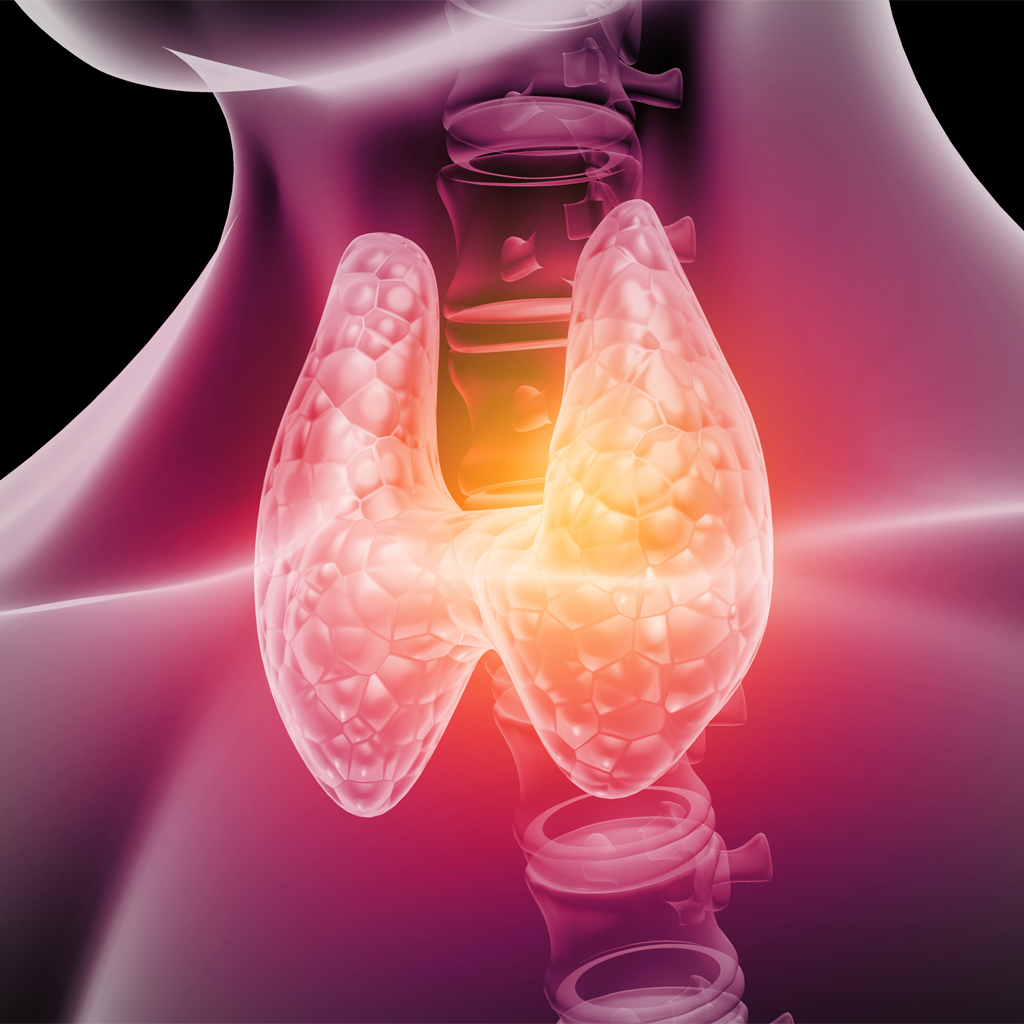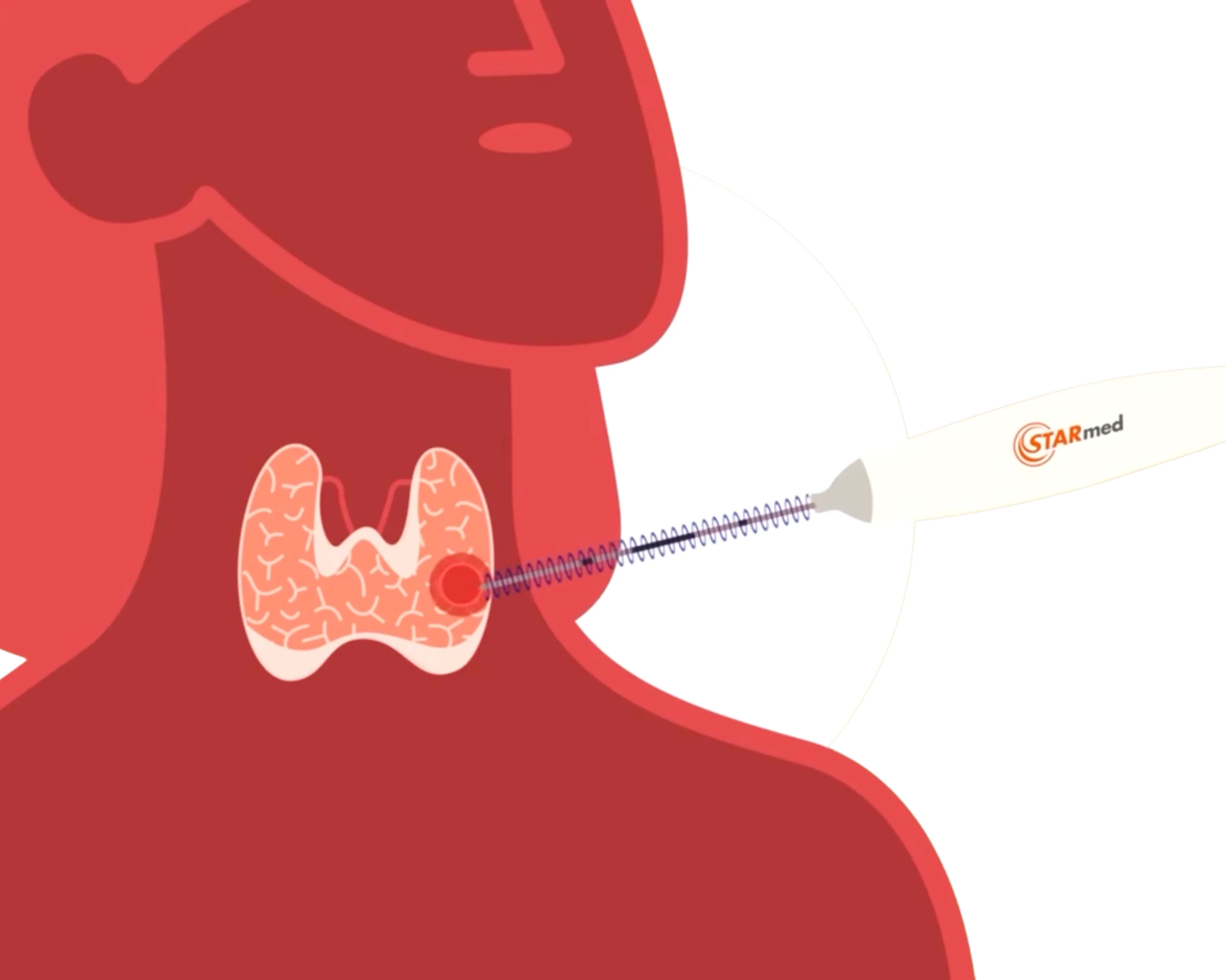Treatment for: Symptomatic thyroid nodules
Procedures offered: Radiofrequency ablation, thyroid artery embolization
The thyroid gland is a small, butterfly-shaped gland in the front of your neck. This gland makes hormones that help control how your body uses energy. There are several thyroid issues that can safely diagnosed and less invasively treated by an interventional radiologist.
What is a thyroid nodule?
Growths on the thyroid gland–called nodules–can grow and become symptomatic. Most of these growths are benign and do not cause problems. But in some cases, they can result in symptoms such as painful breathing, difficulty swallowing, hoarseness, hyperthyroidism (overactive thyroid) or obvious lumps or bumps in the neck.

Treatment Options
If a thyroid nodule isn’t causing symptoms, your doctor will typically recommend monitoring the nodule with a physical exam, ultrasound and thyroid function tests. If the nodule grows larger, or is causing symptoms, a needle biopsy or fine needle aspiration is recommended.
Thyroid nodule biopsy
Using ultrasound to guide the needle, a radiologist can extract a precise biopsy from a thyroid nodule. The sample is sent to a laboratory to determine if the nodule is cancerous or contains abnormal levels of thyroid hormones. Because thyroid nodule ablation is not appropriate for initial thyroid cancer treatment, we require two negative thyroid nodule biopsies – allowing us to be confident the nodule is benign.
If treatment for the nodule is required, there are several treatment options available to patients:
Hormone Therapy
If the thyroid gland isn’t capable of making a sufficient amount of thyroid hormone, a synthetic hormone is usually given in pill form.
Antithyroid Medication
If the thyroid is producing too much hormone, medication can be used to block the production of thyroid hormone.
Surgery
If a nodule is large and causing symptoms, two surgical options are available. A partial thyroidectomy or total thyroidectomy, depending on your unique condition. However, hyperthyroidism may develop as a result of either procedure, requiring life-long hormone medication. In addition, surgery may leave a neck scar.
Minimally Invasive Techniques Offered by North Star Vascular and Interventional:

Radiofrequency Ablation (RFA)
Today, a less invasive and highly precise treatment is available to shrink and remove benign thyroid nodules. The interventional radiologist can also remove the nodule, using heat to spark a reaction that shrinks the nodule tissue. This is a precise treatment that targets only the nodule, without damaging the surrounding healthy tissue or compromising normal thyroid functions.
Thyroid Artery Embolization
Reserved for patients with large thyroid goiters. In this procedure, a doctor uses special tools to put tiny particles into the blood vessels that supply blood to the thyroid gland. These particles block the blood flow to certain parts of the thyroid. This can help shrink the thyroid if it’s too big or reduce the activity of the thyroid if it’s making too much hormone. The procedure is done through a small tube called a catheter, which is inserted into a blood vessel in the leg or arm and guided to the thyroid arteries.
In addition to being safer for the patient, these minimally invasive interventional radiology techniques are less expensive than surgery and are performed on an outpatient basis, with the ability to return home the same day as the procedure. It’s a less invasive option compared to surgery and can be a good choice for people who may not be able to have surgery or prefer a less invasive treatment.
Radiofrequency Ablation FAQs
Before the ablation, the patient lies down on a comfortable table with a mild neck extension (chin up). A grounding pad is attached to the thigh. It may be necessary to shave the hair on the thigh to properly place the pads. The neck is cleaned and towels and drapes are placed over your body. A thorough ultrasound exam is done examining the thyroid nodule. The skin over the thyroid is numbed with numbing medicine. The ablation needle is then placed into the nodule and adjusted multiple times to treat as much of the nodule as possible. The needle is removed and a bandaid and ice pack will be placed on your skin. The procedure itself will last about 30 minutes, and an additional hour will be required after the procedure for monitoring if you received sedation.
You must not eat or drink most beverages 8 hours prior to your procedure. You can drink clear liquids until 2 hours prior to the procedure but have no food or drinks of any kind within two hours of your procedure. Also, please do not wear makeup, lipstick or any jewelry on the day of your procedure. This procedure can be safely done without sedation, which would minimize restrictions prior to your procedure.
We will review the list of your medications and give you instructions or recommendations. In most cases, your medications will not affect the procedure.
If you are anxious, we can provide an anti-anxiety medication 30 minutes prior to the procedure. You will not be able to drive a car, so please arrange to have someone drive you to and from the procedure. We can discuss using deeper sedation as well, which will come with more pre- and post-procedure restrictions such as the need for earlier arrival, an empty stomach, a chaperone to drive and stay with you and recovery for at least 1 hour after the procedure.
Please inform your doctor if you have a pacemaker, and implants or implanted devices, are pregnant, are on medications (especially blood thinners).
You can return to your regular daily activities as soon as you leave our center. You can walk or drive so long as no sedatives have been given.
Unless you have pain or have signs of an infection, you will not need any special medication. If you currently take medication, you will be able to resume taking them at any time after your procedure.
